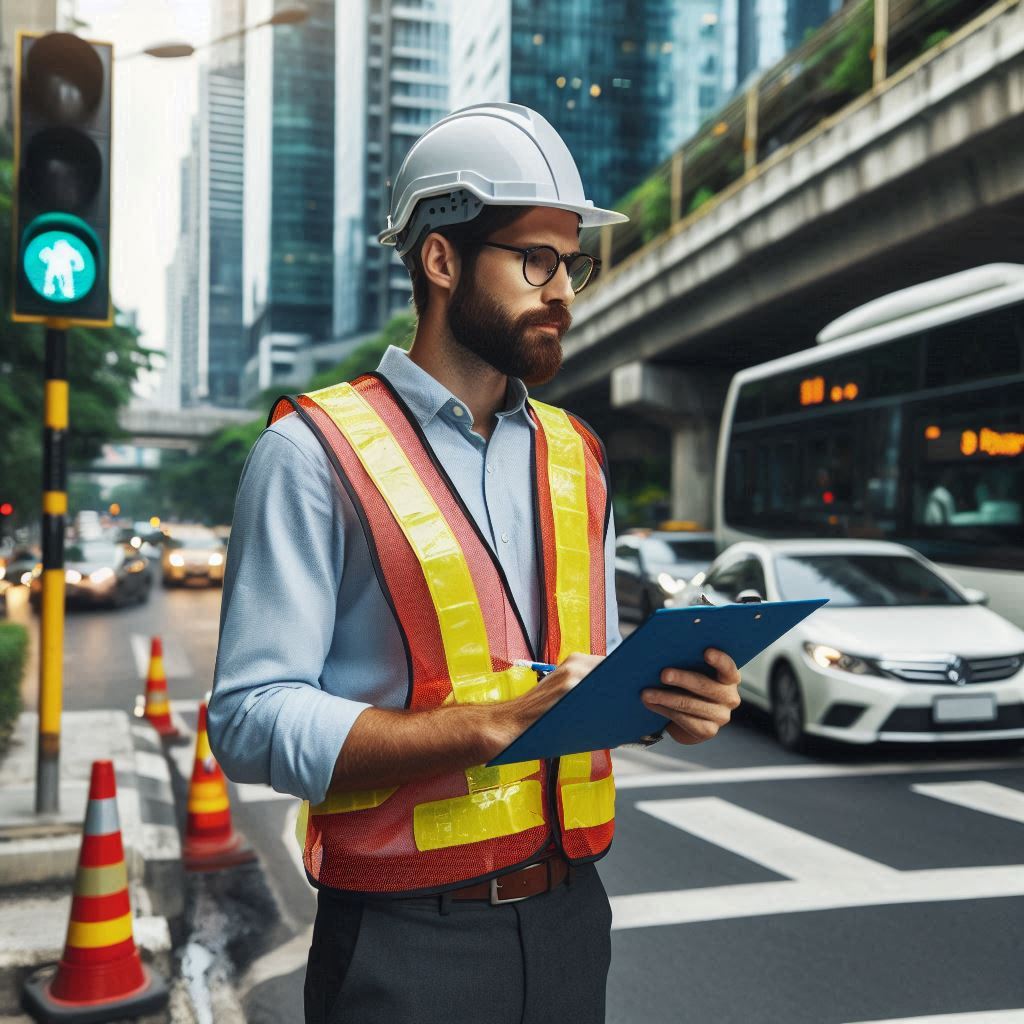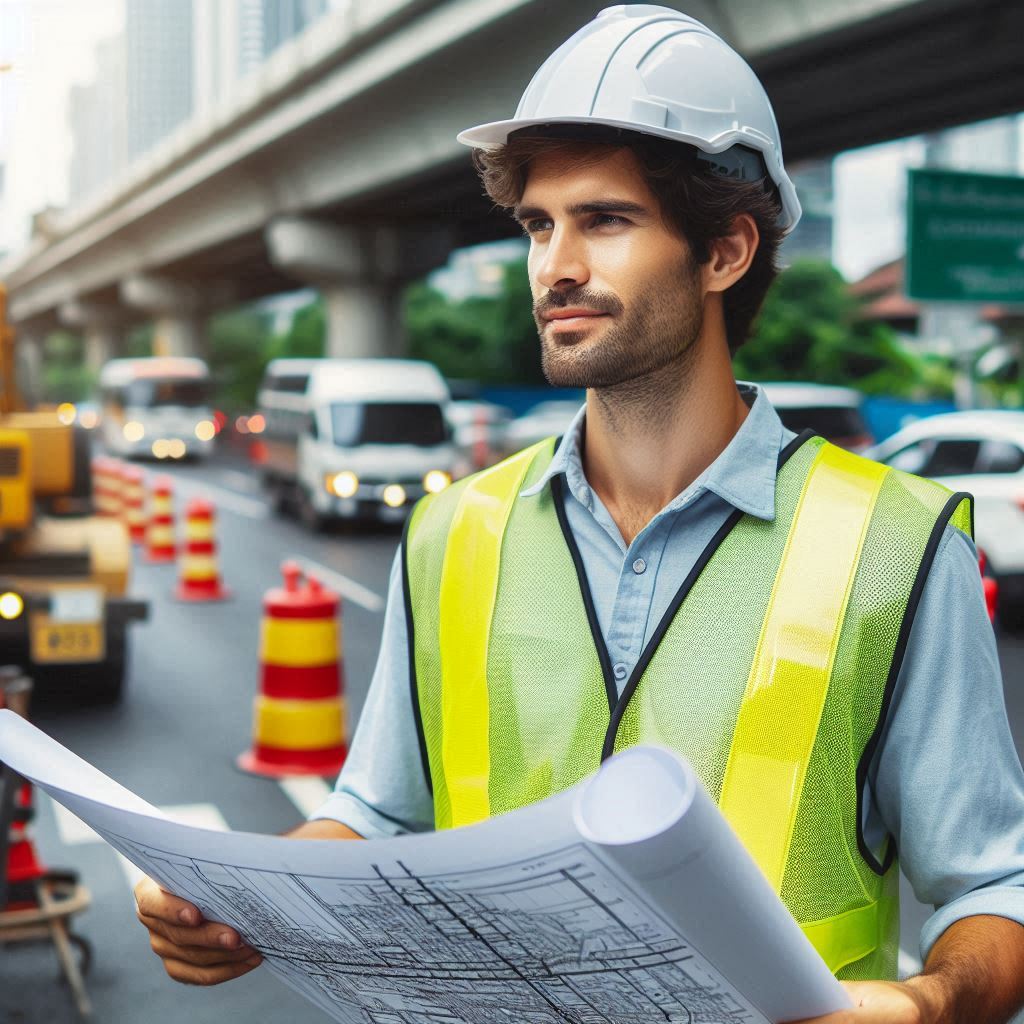Introduction
Traffic congestion refers to the overcrowding of roadways, leading to slower speeds and longer travel times.
It results from an imbalance between road capacity and vehicle demand.
Transportation engineers play a crucial role in mitigating this issue.
They analyze traffic patterns and develop solutions to enhance flow and reduce delays.
Effective management of traffic congestion involves various strategies.
Engineers use advanced technologies to monitor real-time traffic conditions.
They design intelligent transportation systems (ITS) that optimize signal timings and manage traffic more efficiently.
Implementing these systems can significantly decrease congestion and improve travel times.
Transportation engineers also focus on improving infrastructure.
They plan and design roads, intersections, and public transportation systems to accommodate growing traffic demands.
By expanding road capacity and enhancing alternative transportation options, they aim to reduce the strain on existing infrastructure.
Another key strategy involves promoting alternative modes of transport.
Engineers advocate for public transit, cycling, and walking as viable options.
Encouraging these alternatives helps decrease the number of vehicles on the road, thus alleviating congestion.
Ultimately, transportation engineers are essential in developing and implementing solutions to traffic congestion.
Their work not only improves travel efficiency but also enhances overall road safety.
Through innovative approaches and careful planning, they address the challenges posed by increasing traffic volumes.
Identifying traffic patterns
Conducting Traffic Studies to Analyze Traffic Flow
Traffic congestion presents a significant challenge in urban areas.
Conducting comprehensive traffic studies is essential for managing and mitigating this issue.
These studies focus on analyzing traffic flow to identify peak traffic hours and congestion hotspots.
By leveraging various data collection methods, engineers can develop effective strategies to improve traffic conditions.
Using Data to Identify Peak Traffic Hours
One of the primary goals of traffic studies is to determine peak traffic hours.
These are times when roads experience the highest volume of vehicles.
Engineers use traffic volume counting to gather data on vehicle numbers at specific locations.
Sensors installed on roads count the vehicles passing by, providing detailed insights into traffic density.
By analyzing this data, engineers can pinpoint peak hours when traffic congestion is most severe.
Traffic cameras also play a crucial role in identifying peak traffic hours.
These cameras offer real-time observations of traffic conditions.
By reviewing footage, engineers can detect patterns and trends in traffic flow.
This visual data helps in understanding when and where congestion is likely to occur.
Another valuable tool is GPS tracking technology.
Engineers use data from navigation apps to monitor vehicle speeds and travel times.
This information helps to identify areas with significant delays and high traffic volumes.
GPS data allows engineers to accurately determine peak traffic hours and plan accordingly.
Identifying congestion hotspots is another critical aspect of traffic studies.
These hotspots are specific locations where traffic consistently becomes heavy.
To pinpoint these areas, engineers use a combination of data collection methods.
Traffic volume counts and camera footage provide initial insights into where congestion occurs frequently.
Read: Biomedical Engineering: Industry Outlook 2024
Designing Efficient Road Networks
One of the key strategies that transportation engineers use to address traffic congestion is designing efficient road networks.
This involves creating road layouts that are specifically optimized to improve traffic flow and reduce bottlenecks.
Creating Road Layouts to Optimize Traffic Flow
Transportation engineers carefully design road layouts to ensure the smooth movement of vehicles through intersections and along major thoroughfares.
This may involve widening roads, creating dedicated turning lanes, and strategically placing traffic signs and signals.
By optimizing the layout of roads, engineers can help to minimize congestion and reduce delays for commuters.
This is especially important in high-traffic areas such as city centers and major highways where traffic bottlenecks are common.
Implementing Lane Configurations and Traffic Signals
In addition to designing road layouts, transportation engineers also focus on implementing lane configurations and traffic signals that can help improve traffic flow.
This includes adding extra lanes during peak hours, creating dedicated bus lanes, and adjusting traffic signal timings to reduce wait times.
By carefully analyzing traffic patterns and volume, engineers can determine the most effective lane configurations and signal timings to keep traffic moving smoothly.
This proactive approach can help to prevent congestion before it becomes a major issue.
Overall, designing efficient road networks is a vital part of the work that transportation engineers do to address traffic congestion.
By creating optimized road layouts and implementing effective lane configurations and traffic signals, engineers can help to improve traffic flow and reduce delays for commuters.
This proactive approach is essential in managing congestion in our increasingly crowded roadways,
Implementing technology solutions
Intelligent transportation systems (ITS)
One of the key ways transportation engineers address traffic congestion is through the implementation of intelligent transportation systems (ITS).
These systems utilize advanced technologies to improve the efficiency and safety of transportation networks.
By installing ITS, engineers are able to monitor and manage traffic flow in real-time. This allows them to make data-driven decisions and implement strategies to reduce congestion and improve overall traffic conditions.
ITS can include a range of technologies such as traffic signal control systems, variable message signs, and electronic toll collection systems.
These tools help to optimize traffic flow and improve the overall functioning of transportation networks.
Traffic monitoring cameras and sensors
Another important technology solution used by transportation engineers is the deployment of traffic monitoring cameras and sensors.
These devices are strategically placed throughout roadways to gather data on traffic patterns and vehicle movements.
By collecting real-time data from cameras and sensors, engineers are able to assess traffic conditions and identify areas of congestion.
This information is then used to develop targeted strategies to alleviate traffic bottlenecks and improve the flow of vehicles.
Additionally, traffic monitoring cameras can be used for enforcement purposes, such as capturing images of vehicles running red lights or speeding.
This helps to enhance safety on the roads and deter risky driving behavior.
Benefits of technology solutions
The implementation of technology solutions like ITS and traffic monitoring cameras offers numerous benefits for addressing traffic congestion. Some of these advantages include:
- Improved traffic flow: By using real-time data and intelligent algorithms, engineers can optimize traffic flow and reduce congestion on roadways.
- Enhanced safety: Technology solutions can help to identify and address safety hazards, improving overall road safety for drivers and pedestrians.
- Increased efficiency: By streamlining traffic management processes, technology solutions can make transportation systems more efficient and cost-effective.
- Data-driven decision-making: With access to accurate and up-to-date data, engineers can make informed decisions to proactively manage traffic congestion and improve transportation networks.
Overall, the implementation of technology solutions plays a critical role in the efforts of transportation engineers to address traffic congestion and create safer, more efficient roadways for all users.
Read: Biomedical Engineering: Impact on Public Health
Public transportation improvements
Promoting the Use of Public Transportation to Reduce Single-Occupancy Vehicles
One strategy to alleviate traffic congestion is promoting public transportation.
Traffic studies reveal that single-occupancy vehicles contribute significantly to congestion.
By encouraging the use of buses, trains, and subways, cities can reduce the number of cars on the road.
Engineers analyze traffic patterns to determine the best locations for public transportation routes.
Effective public transportation reduces overall traffic volume and alleviates congestion during peak hours.
Designing Efficient Bus Routes and Implementing Bike Lanes
Another way to address congestion is by designing efficient bus routes and implementing bike lanes.
Traffic studies help engineers identify areas where buses can operate efficiently.
By creating dedicated bus lanes and optimizing routes, cities can improve public transportation efficiency.
Additionally, bike lanes provide an alternative to driving, reducing the number of vehicles on the road.
Engineers use traffic data to determine the best locations for bike lanes, ensuring they connect key destinations and promote cycling.
Effective communication with local authorities and stakeholders is also crucial.
Engineers present their findings to decision-makers, ensuring that traffic management strategies are well-informed and community-focused.
Collaboration with stakeholders helps prioritize improvements and implement effective solutions.
Therefore, conducting traffic studies is essential for managing traffic congestion.
By promoting public transportation, designing efficient bus routes, implementing bike lanes, and using comprehensive data analysis, engineers can address congestion effectively.
Understanding traffic patterns through various data collection methods enables the development of targeted strategies that improve overall traffic flow and reduce congestion
Transform Your Career Today
Unlock a personalized career strategy that drives real results. Get tailored advice and a roadmap designed just for you.
Start NowRead: Graduate Studies in Biomedical Engineering

Traffic Control Measures
Implementing Strategies such as Congestion Pricing and Carpool Lanes
Once engineers identify peak traffic hours and congestion hotspots, they can develop targeted strategies.
Congestion pricing is one such strategy, where drivers pay a fee to use congested roads during peak times.
This approach discourages excessive use and reduces congestion.
Carpool lanes are another effective measure.
These lanes are reserved for vehicles with multiple occupants, encouraging carpooling and reducing the number of cars on the road.
Implementing these lanes helps improve traffic flow and lower congestion levels.
Conducting Traffic Impact Assessments for New Developments
Traffic studies also play a crucial role in evaluating the impact of new developments.
Engineers conduct traffic impact assessments (TIAs) to understand how proposed projects will affect existing traffic conditions.
These assessments analyze potential increases in traffic volume and identify possible congestion points.
TIAs help in planning appropriate mitigation measures to address any adverse effects on traffic flow.
For instance, engineers may recommend road improvements, traffic signal adjustments, or additional lanes to accommodate the increased traffic.
Effective communication with local authorities and stakeholders is essential throughout this process.
Engineers present their findings to decision-makers to support planning and policy changes.
Collaboration ensures that traffic management strategies are informed by data and tailored to community needs.
In general, conducting traffic studies is vital for managing traffic congestion.
Engineers use various data collection methods, including traffic volume counting, cameras, GPS tracking, and surveys.
Analyzing this data helps identify peak traffic hours and congestion hotspots.
Strategies like congestion pricing and carpool lanes can mitigate congestion, while traffic impact assessments ensure new developments do not exacerbate existing issues.
Read: Biomedical Engineering: Regulatory Affairs
Gain More Insights: Professional Organizations for Computer Engineers
Collaborating with city planners
Working with Urban Planners to Integrate Transportation Solutions with City Development
Urban planners and transportation engineers must collaborate to integrate transportation solutions with city development.
Traffic studies provide critical data that informs urban planning decisions.
For example, understanding traffic patterns helps planners design roads and intersections that accommodate high traffic volumes.
Engineers and planners work together to ensure that new developments include effective transportation infrastructure.
This collaboration involves designing roads, public transit options, and pedestrian pathways that align with existing traffic patterns.
By integrating these solutions, cities can prevent future congestion issues.
Advocating for Mixed Land Use to Reduce Commuting Distances
Traffic studies also reveal the benefits of mixed land use.
Mixed land use refers to combining residential, commercial, and recreational spaces in a single area.
This approach reduces the need for long commutes and can significantly lower traffic congestion.
Engineers use data from traffic studies to advocate for mixed land use.
They demonstrate how reducing commuting distances can decrease overall traffic volumes.
By presenting evidence from traffic studies, engineers support urban planners in creating more walkable and bike-friendly communities.
Effective communication with local authorities and stakeholders is essential.
Engineers present their findings to decision-makers to support planning and policy changes.
Collaboration ensures that traffic management strategies are informed by data and tailored to community needs.
All in all, conducting traffic studies is vital for managing traffic congestion.
Engineers use various data collection methods, including traffic volume counting, cameras, GPS tracking, and surveys.
Analyzing this data helps identify peak traffic hours and congestion hotspots.
This information, combined with collaboration with urban planners and advocacy for mixed land use, is crucial for developing effective traffic management strategies and improving overall traffic flow.
Learn More: Essential Tools for Environmental Technicians
Conclusion
Transportation engineers play a crucial role in tackling traffic congestion.
They use data-driven methods to design efficient road systems.
By implementing intelligent transportation systems (ITS), they optimize traffic flow and reduce delays.
Engineers apply traffic simulation models to predict and manage congestion effectively.
They also design better road layouts and signal timings to improve traffic movement.
Looking ahead, transportation engineers are exploring innovative solutions to further alleviate congestion.
Autonomous vehicles hold the promise of reducing human error and improving traffic management.
Smart city technologies, integrating sensors and real-time data, offer potential for dynamic traffic control.
Enhanced public transportation options and multimodal transit solutions are also on the horizon.
These advancements aim to make travel more efficient and sustainable.
In general, transportation engineers are essential in mitigating traffic congestion.
Their work involves creating smarter, more efficient transportation systems.
Future solutions in transportation engineering promise even greater improvements in traffic flow and overall travel experience.
As technology evolves, engineers will continue to play a pivotal role in addressing traffic challenges.




